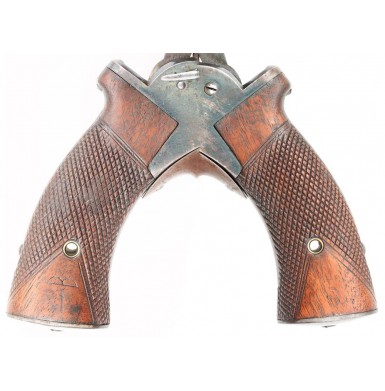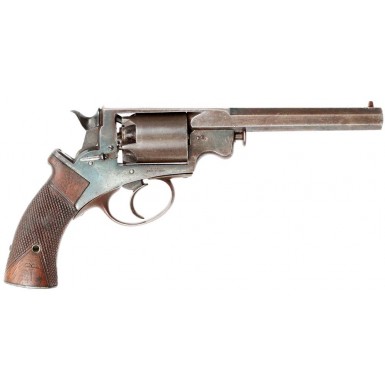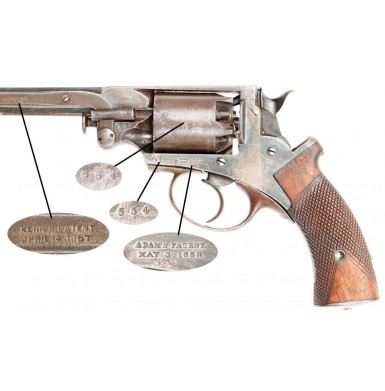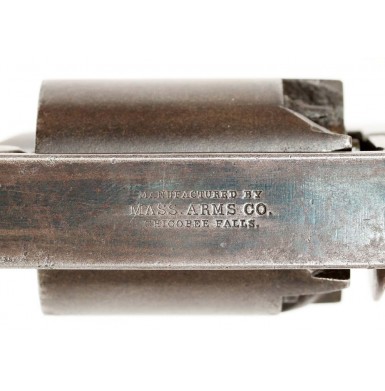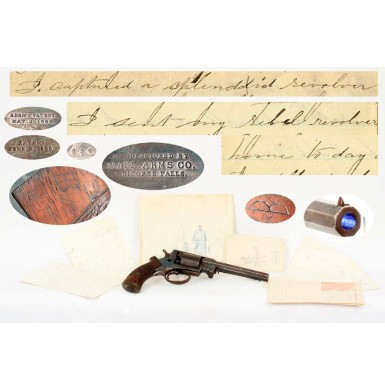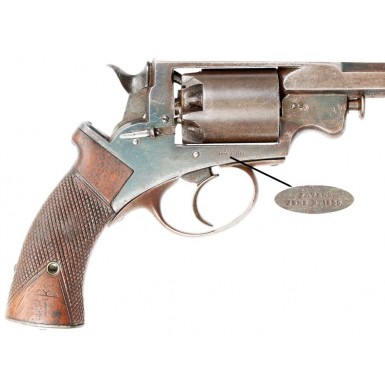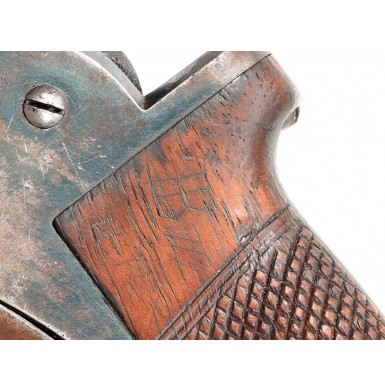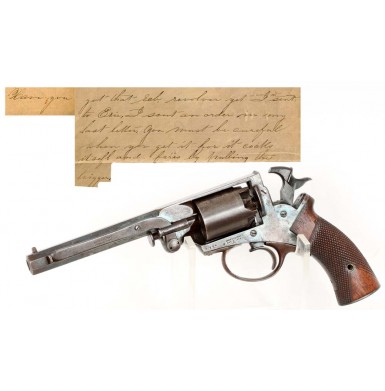Captured Confederate Used Mass Arms Adams
- Product Code: FHG-1853-SOLD
- Availability: Out Of Stock
-
$1.00
“I captured a splendid revolver, our Col. says we can keep all our booty.” - R. Wallace Mitchell in a letter to his brother George, March 19, 1863.
“I am going to send my revolver home if I ever get a chance. I have all the arms I want to carry without it. There would be no trouble in sending it if I can find anyone going, for it is not like the government arms (Colt’s Revolvers) we can’t send any of the Gov’t arms home.” - R. Wallace Mitchell in a letter to his sister Floretia, March 15, 1863
“I sent my rebel revolver home today on to Erie. I mean I will inclose (sic) an order that George can get it. I sent it just as I found it, loaded. I found it when I was fighting dismounted. We had driven the rebels back and some of them dropped the revolver in the skedatle (sic).” - R. Wallace Mitchell in a letter to his sister Mary, April 3, 1863.
“Have you get that reb revolver yet “ I sent it to Erie, I sent an order in my last letter. You must be careful when you get it for it cocks itself and fires by pulling the trigger.” - R. Wallace Mitchell in a letter to his brother George, April 11, 1863.
The above excerpts come from four letters written home by Corporal Robert Wallace Mitchell (Wallace to his friends and family) during the spring of 1863, while he was serving in Virginia with the 16th Pennsylvania Cavalry. The letter discusses the typical things a soldier in the field would talk about with his family at home, from camp and soldier life to asking for more letters and more news from home. Most intriguing, however, is his brief account of the actions taken by his company of the 16th Pennsylvania Cavalry on March 17, 1863 in what Wallace describes as a “big thing for a cavalry fight”. While his letters only refer to the action as having taken place near Culpepper, VA, the battle that Wallace describes from his perspective is Kelly’s Ford, the first really major cavalry engagement of the war, a battle that set the stage for the large scale cavalry encounters of the upcoming summer Gettysburg campaign, including Brandy Station. While histories of the battle are available elsewhere, it is worth noting that once the 2nd Virginia Cavalry was driven from the field during the initial Union advance, the 3rd & 5th Virginia Cavalry counterattacked, only to be repulsed by the sustained and accurate carbine fire of the 16th Pennsylvania Cavalry. As Wallace notes “the squadron I was in dismounted, every fourth man held horses, we went out on the double quick and pluged (sic) away at the retreating rebs, I suppose you think I was excited, scared or something, not a bit. I took just as good aim as though I was hunting squirrels. I couldn’t tell whether I hit any of them or not, I saw a horse stagger where I took aim” During the course of the fight, either when the pickets on the opposite side of the Rappahannock were driven off by the 16th (probably from the 2nd VA Cavalry) or when the 3rd & 5th VA retreated, Wallace recovered a revolver dropped by one of the retreating rebels. This gun was the subject of four different letters home, which detail not only his acquisition but his eventual disposition of the gun, including the comments that the gun was being sent home as he found it, “loaded”, and that “it cocks itself and fires by pulling the trigger.” His description makes it obvious that the gun was a double action revolver, distinctly different from the “government arms (Colt’s Revolvers)” that were carried by Wallace and the other men in his regiment. Were it not for the fact that Robert Wallace Mitchell’s family kept the revolver and letters together in the family, we would not be able to concretely identify exactly what the “reb revolver” was, but thankfully they did. About 1953 a direct descendent of Wallace Mitchell’s family sold the gun and the associated letters (along with some other related ephemera) to John C. Veenschoten, an Erie, PA dealer in antique American furniture, art and antique arms. He retained the gun and letters in his personal collection for another forty years before selling them to a collector in 1993. The gun and letters have remained in that private collection ever since, and this is the first time that the collection has been offered for sale in more than two decades, and only the second time in more than 60 years. What is so interesting about the archive of R. Wallace Mitchell is that the gun he captured from the “rebs’ is a Massachusetts Arms Company Adams’ Patent Revolver.
The story of the Adams Patent Revolvers as produced by the Massachusetts Arms Company is a very interesting one. Robert Adams’ “self-cocking” or “double action” revolver was originally patented in England in 1851, with the primary patent covering his one piece, solid frame and barrel forging. The frame was considerably stronger than the open top, two-piece, wedge retained frame and barrel system used by Colt. Adams instantly found success selling his guns in England, and in 1854 Lt. F.B.E. Beaumont developed an improvement to the lock work, which allowed the pistol to operate in both conventional single action and double action modes. It was this variation of the Adams revolver (the M-1854 or “Beaumont-Adams”) that was produced under license by the Massachusetts Arms Company of Chicopee Falls, MA. In 1857 Massachusetts Arms entered into an agreement to provide 500 of the “belt” sized (.36 caliber), Beaumont-Adams Patent revolvers to the US Ordnance Department. Ordnance Department Head Colonel H.K. Craig had purchased 100 of the English made Beaumont-Adams revolvers the previous year, in .36 caliber, since it was the caliber of the Colt revolvers (M-1851 “Navy” revolvers) most in use by the US military at that time. After issue and use in the field during 1856, Craig wrote to the Secretary of War “I think very favourably (sic) of the arm”.as being well adapted to Military use, and as the price is considerably less than”.the Colt Pistol, to which it is quite equal and, in some respects, in my opinion superior.” Craig was no doubt referring to the robust solid frame of the guns, when calling them “superior” to the Colt. On July 24, 1858 The Massachusetts Arms Company delivered the first 250 of the Beaumont-Adams revolvers to the Ordnance Department, and delivered another 150 on August 17 and the last 100 on September 4 of the same year. Massachusetts Arms saw only limited civilian sales of the revolvers during that period, and it is believed that the highest serial number delivered to the US Ordnance Department was 609, indicating that 100 or so were manufactured for private sale, or rejected by the Ordnance Department during that period. The revolvers delivered by the Mass Arms Company had 6” octagon barrels and five shot cylinders, and used the Kerr’s patent loading lever attached to the left side of the frame. They were blued with checkered one-piece walnut grips that were pierced in the center for the attachment of a lanyard. It has long been believed that that state of Virginia also acquired 1,000 of these revolvers via the Ames Manufacturing Company of Chicopee, MA in an arms order from May of 1860, and delivered during the summer and fall of that year. While period documents refer to the revolvers as being “1,000 Deane & Adams’ Pistols”, a somewhat more accurate period description comes from Harper’s Ferry master armorer Phillip Burkhart (who went on to superintend the Confederate arsenal in Fayetteville, NC) as “.pistols (Army Size) ”by Dean & Adams Chicopee Falls Massachusetts.”. While Burkhart implied the incorrect caliber (“Army” usually meant “.44” during the period), the Massachusetts Arms Company “belt model” .36 caliber (“Navy” in period parlance) revolver was built on the same sized frame a .443 caliber English made M-1854 Adams Revolver. According to Chamberlain & Taylerson in Adams’ Revolvers, the guns were delivered from stock on hand in September of 1860, and were delivered to Virginia along with 1,000 Cavalry Sabers and 200 Light Artillery Sabers. It must be remembered that for all practical purposes the Massachusetts Arms Company was a subsidiary of the Ames Manufactory (both located in Chicopee, MA) and had been largely financed by the Ames family and was largely controlled by Ames family members on the board of directors. While references like Flayderman’s Guide to Antique American Firearms list approximately 1,000 as the total number of large frame “Navy” model Adams revolvers produced by Mass Arms, the reality is that at least 1,500 had to have been manufactured, in order to fill both the 500 gun order for the US military and the additional 1,000 gun order for Virginia. At least some of these Mass Arms Adams revolvers had been issued by Virginia by November of 1860, as article in the November 26, 1860 Springfield Daily Republican noted that “There is a company of men about organizing at Richmond, to be armed with double-barreled guns, five shooters and bowie knives, to be ready for the call of the governor at a minute’s warning, to defend the rights of Virginia.” The reference to “five shooters’ strongly suggests the 5-shot Mass Arms Adams revolvers. Period documents indicate that portions of the 1st and 5th Virginia Cavalry were definitely armed with Adams revolvers (likely the Mass Arms guns), and no doubt a number of other early regiments saw at least a handful of the guns in service as well.
The Massachusetts Arms Company Adams Patent Revolver that was captured by R. Wallace Mitchell is offered here for sale with the original letters from Wallace to his family regarding the revolver, as well as a notarized affidavit from Mr. Veenschoten regarding his purchase of the revolver along with the letters from descendants of Wallace’s family in Erie, PA sometime around 1953. In addition to the letters and their original covers, several sketches of camp life by Wallace are included, which have some light hand coloring. Additional documents include a ledger book that contains historical notes, transcriptions of other letters from Wallace from the Civil War (original copies are not included), as well as what appears to be a list of members and wives of the 16th PA who attended a reunion. Also included are numerous type-written transcriptions of letters (primarily from Wallace’s brother George) to the family during his war time service. Robert Wallace Mitchell was born in 1835 in New York, and according to the 1860 Census he was residing with his parents in Green Township, Erie County, PA as of August 23, 1860 (the day the Census was recorded). “Robert W Mitchell” as he is listed in the Census was 24 years old, and was employed as “farm laborer”. His father, also named Robert, was 52 years old and is noted as being a farmer with real estate valued at $2,500 and a personal estate valued at $800. The other members of the Mitchell household included the wife of Robert senior, Celia (56) and Robert W.’s three sisters and one brother: Nancy F. (21), Mary F. (19), George B (18) and Floricia A (13). As Robert writes to his sister “Floretia” in one of the included letters, it is not clear if it is his spelling or that of the Census taker that is the correct one for her name. With the outbreak of the American Civil War Wallace immediately sprang to action by joining McLane’s Erie Regiment, a 3-month unit organized in April of 1861 by John W. McClane (who was of course elected colonel). The regiment was organized in the town of Erie, PA in less than a week and was subsequently sent by rail to Pittsburgh where it camped and drilled and was never mustered into Federal service before being disbanded in early July of 1861. Interestingly, following the Union loss at Manassas (Bull Run) on July 21 of 1861 the unit was reorganized as a three-year regiment, including some 300 of its original members and was accepted into service as the historic 83rd Pennsylvania Infantry, which would go on to to great honor and glory fighting at the right flank of the 20th Maine on Little Round Top. Wallace, however, did not re-enlist in the Erie Regiment and instead enlisted in Troop (Company) C of the 16th Pennsylvania Cavalry on September 6, 1862, where he was mustered in as a corporal; no doubt due to his previous “military experience”. The regiment was initially mustered as the 161st PA Volunteers, but was soon re-designated as the 16th PA Cavalry. The regiment was organized at Camp Curtin (named for Pennsylvania Governor Andrew Curtin) in Harrisburg, PA. During their organization and training in the fall of 1862, Wallace took it upon himself to sketch some of the scenes of camp life in the army. Six of his sketches of life at Camp Curtin are included with this archive, each being part of a small booklet measuring approximately 7 ““ x 6 ““ (with the exception of “Our Home No 9”, which is separate and smaller) and these are titled and dated as follows:
“Carrying Water” 1862
“Hospital Buildings Camp Curtin” Sept. 22, 1862
“Our Tent” Sept 25, 1862
“Rebel Prisoners’ Sept 26, 1862
“Erie Cavalry” Oct 4 1863
“Our Home No 9” Oct 21, 1862
The 16th Pennsylvania Cavalry regiment was initially under the command of Colonel John Irvin Gregg, a Mexican War veteran who would soon become a cavalry brigade commander in the Army of the Potomac and would briefly be given command of the entire Army of the Potomac’s cavalry corps during February of 1865. After training and outfitting was completed the regiment was moved to the defenses around Washington in late November of 1862. Wallace provides one additional sketch (much smaller than the others) with the archive, which is entitled “Cooking At Camp Casey” which was near Bladensburg, MD and was where the 16th PA was located from December 1862 until early January 1863. On January 3, 1863 the regiment moved to Falmouth, VA and from there to duty along the “Rappahannock Line” where they would remain until early April of 1863. While serving in this capacity they were involved in their first major fight, the Battle of Kelly’s Ford on March 17, 1863. This was one of the first large scale cavalry battles of the war, and was one of the first times that the Union cavalry was not trounced by the Confederate horsemen. Confederate General J.E.B. Stuart’s chief of artillery, the “gallant” Major John Pelham was killed at Kelly’s Ford. From Kelly’s Ford the 16th Pennsylvania went on to serve in almost every major battle and operation that the Army of the Potomac participated in until the end of the war. These actions included the following: The Gettysburg Campaign, The Bristoe Campaign, Mine Run, Cold Harbor, Trevilian Station, The Siege of Petersburg (including Ream’s Station, Boydton Plank Road and Hatcher’s Run) and the Appomattox Campaign (including Five Forks, Sailor’s Creek & Appomattox Court House). The regiment would eventually lose some 302 men during the war, including 100 enlisted and 5 officers killed or mortally wounded and 194 men and 3 officers to disease. Sadly, Robert Wallace Mitchell was one of the many men who would eventually succumb to disease. He remained in service with the regiment through 1863 and much of 1864, and his name appears on the 16th PA Cavalry monument at Gettysburg as having been an active participant in that battle. Sometime during the fall of 1864 he developed consumption (tuberculosis) and was sent home on furlough. Wallace died of the disease on December 1, 1864 and is buried in North East Cemetery in Erie, PA. Wallace’s brother George is buried with him, under the same monument. In 1864 George followed Wallace into service, enlisting with the 16th PA Cavalry as well, and serving in Troop C as Wallace had. George was killed on March 31, 1865 at Dinwiddie Court House, where he was shot through the head and left upon the field. His body was recovered some time after the engagement. As neither Wallace who captured this revolver, nor George whom he sent it home to, survived the war, the revolver descended through the Mitchell family sisters, along with the letters home from Wallace and George.
In my mind, this gun with its provenance concretely establishes the characteristics of some of those “Adams’ revolvers acquired by the State of Virginia in 1860. It is a large frame Massachusetts Arms Company 5-shot .36 Adams Patent revolver that bears no US government inspection marks and is serial numbered above 500. The gun is serial number 554 and is so marked on the left side of the frame forward and below the cylinder and on the cylinder itself. The lower right side of the frame is marked in two horizontal lines: PATENT / JUNE 3, 1856 and the lower left side of the frame is marked ADAMS, PATENT / MAY 3, 1853. The top strap is marked in three lines: MANUFACTURED BY / MASS. ARMS CO. / CHICOPEE FALLS. The loading lever is marked in two lines: KERR’s . PATENT / APRIL 14, 1857. All of the markings remain crisp and quite legible. The gun is in about FINE condition, and retains a significant amount of original blued finish, mixed with a smooth plum-brown patina over all of the metal components. There are some small, scattered patches of minor peppering and pinpricking on the metal as well as some minor flecks of scattered surface oxidation. The frame retains about 20%+ of its original blued, mixed with a mostly smooth plum-brown patina, and the barrel retains about 30%+ original blue, with the area protected by the loading lever and the bottom of the barrel retaining the largest percentages of bright blue. The cylinder retains only some lightly flecked traces of original finish, over a mostly brownish patina. As would be expected of a revolver that saw cavalry service with the south for the first two years of the war, there are a handful of minor impact marks present on the frame, cylinder and topstrap. The hammer retains none of its original mottled case colored finish, but has a deep, dark, smoky blue-gray patina. The screws remain in mostly crisp condition and there is still a nice remnant of the fire-blued finish on the heads of many them. The action of the revolver functions well, in both the double action and single action modes. However, the trigger return spring is broken or weak and the trigger must be manually returned to the forward position after it is pulled. This is a common problem with Adams patent revolvers that are found today. The revolver times, indexes and locks up as it should. The original frame mounted sliding safety is present on the right side of the pistol. It retains about 30% of its original fire-blued finish and functions correctly. The fragile thumbscrew style cylinder pin retaining screw is broken off, leaving only the body of the screw in the frame. The thumbscrew was notoriously weak and subject to breakage and they are often missing from both English and American made Beaumont-Adams revolvers. The body of the screw is in the “release” position, meaning that the cylinder arbor pin can be easily withdrawn and is not secured in the frame. Caution must be used when handling the revolver to make sure the pin does not slip out. A couple of small dabs of clear nail polish would provide enough resistance to keep the pin in place, and still allow it to be easily removed. The original “Kerr’s Patent” loading lever is present on the left side of the frame and functions correctly. The lever is marked in two lines KERR’s PATENT / APRIL 14, 1857 but is not marked with the patent tracking number, which appears on slightly later production Mass Arms Adams revolvers. This is not a serial number, but rather a method of tracking the royalty payments that Mass Arms owed to Kerr for the use of the design. Since the same patent applied to the loading lever on the .36 caliber belt revolvers and the .31 pocket version, the numbers simply tracked the number of levers consecutively produced under that patent. However, the numbers do not appear on the large frame revolvers until the high 500 to low 600 serial number range, and in the upper end of the pocket revolver serial numbers. The number never matches the serial number of the pistol that the levers are attached to. The loading lever retains the original spanner style mounting screw, which is often missing as well. The five shot cylinder retains five period cones (nipples), but of the five one is a period replacement and three are damaged. The damaged cones are likely from the gun being played with over the generations as it was passed down through the family. The bore of the pistol is in NEAR VERY GOOD condition. It is dark and seasoned, but retains strong, sharp rifling, showing only light pitting evenly distributed along its length. The original iron blade front sight is dovetailed into the top of the 6” octagon barrel, and the barrel retains sharp edges and good lines. The checkered walnut grips are in about FINE condition, and are free of any breaks, cracks or chips. The checkering shows light to moderate wear from actual use. The original brass ferrules remain at the edges of the lanyard hole that passes through the center of the grip. The grip has the initial B lightly scratched into it in several places, with a more complex series of initials including a “B” on the upper right side where the grip and frame meet. This is too light for me to read, but some hard work might make them decipherable. The initials are likely those of the Virginia cavalryman who dropped the gun when he “skedaddled”.
As previously noted the revolver is accompanied by a large selection of documentation both period and contemporary. Included are four letters from Wallace to his family (two to George, one to Mary and one to Floretia), these are written front and back on period lined, letter sized paper, that measures approximately 10” x 8” and is folded in half. The letters are written in ink quite legibly in a fine hand. The final letter is written on two pieces of paper, the last piece having a patriotic embellishment. The paper remains in fine, solid condition and shows some age toning and minor foxing, while the ink has faded slightly. The covers for the four letters are included as well, complete with stamps, cancellations and in one case a notice of postage due. The seven original pencil sketches discussed above are included as well, with the first five contained in small booklet that measures about 7 ““ x 6 ““ and with two additional loose sketches, “Our Home No 9” measuring about 7 ““ x 5” and the tiny “Cooking At Camp Casey” measuring about 5” x 3”. Many of the sketches have some rudimentary hand coloring, but all are artfully executed with a sense of humor, with “Our Tent” showing only Wallace’s feet sticking out of it, and his valise with the RWM initials next to them. His sketch of “Rebel Prisoners’ is particularly interesting as it is dated September 26, 1862 only nine days after the battle of Antietam at Sharpsburg, MD. These prisoners are particularly ragged and conform well to period reports that describe Lee’s Army as being in terrible shape in terms uniforms and shoes as they marched from Virginia to Maryland. The sketches are all in very nice condition with the paper showing age and toning, but images remaining crisp and clear. The pictures in the booklet are separated by heavily foxed tissue weight paper. In addition to the original sketches, high resolution scanned copies are included as well. Three CS notes, a $5, $10 and $20 are included as well, likely sent home by George at some point during his service as all are 1864 dated. A scan of the three note fronts is below the pictures of the gun. As mentioned there is also an extensive archive of typed transcriptions of letters from Wallace’s brother George as well as some hand written transcriptions in an old ledger book, but the original letters are not present. Two letters from the antique dealer that turned up the collection in the 1950s are included, one a basic description of the original findings and the second a notarized statement about their acquisition. Copies of information related to the 16th PA Cavalry and R Wallace Mitchell are also included, covering everything from his muster records to a photo of his grave. All is contained in a nice binder with archival quality pockets to protect the documents both old and new. Scans of the sketches are shown below the photos of the gun, as well as a scan of one of Wallace’s letters home.
Overall this is one of the most historically interesting groups of artifacts that I have had the opportunity to offer for sale. Rarely can collector or dealer directly tie a single artifact to a specific event or battle so concretely. This gun and its accompanying letters from Wallace prove beyond a shadow of a doubt that Virginia had Massachusetts Arms Company Adams revolvers in service with Virginia Cavalry regiments during the first half of the Civil War. The double action design of the revolver was so unique and interesting to Wallace that he commented about it in his letters home. This gun was picked up at Kelly’s Ford, likely from a member of the 2nd, 3rd or 5th Virginia Cavalry, and was sent home by a patriotic soldier who would go on to fight at Gettysburg and the rest of the Army of the Potomac cavalry campaigns through the fall of 1864, when he would die at home on furlough of consumption, a fate much more common to the Civil War soldier than dying in battle. Rarely have I had the opportunity to offer so much history for sale in a single firearm and associated documents. The letters and drawings alone are historically significant, but taken with the revolver together are nearly priceless for the arms researcher and Civil War historian. This is a collection that deserves to be kept together and displayed as a central piece of a very advanced Civil War arms collection.
Provenance: descended through the Mitchell family March 1863 until 1953, John C. Veenschoten Collection 1953-1993, private Kansas collection 1993-2016, Philip B. Ennis Collection of Historic Confederate Militaria 2016.
SOLD

